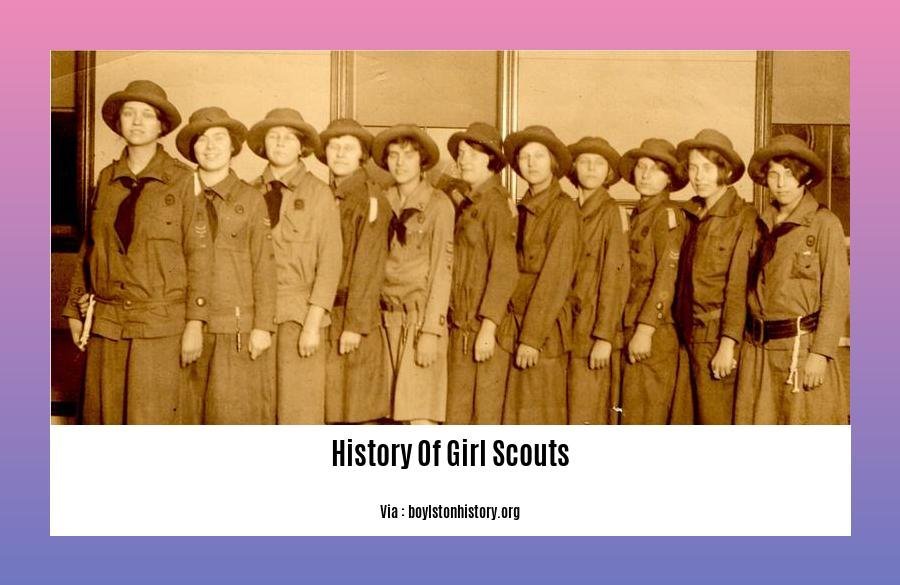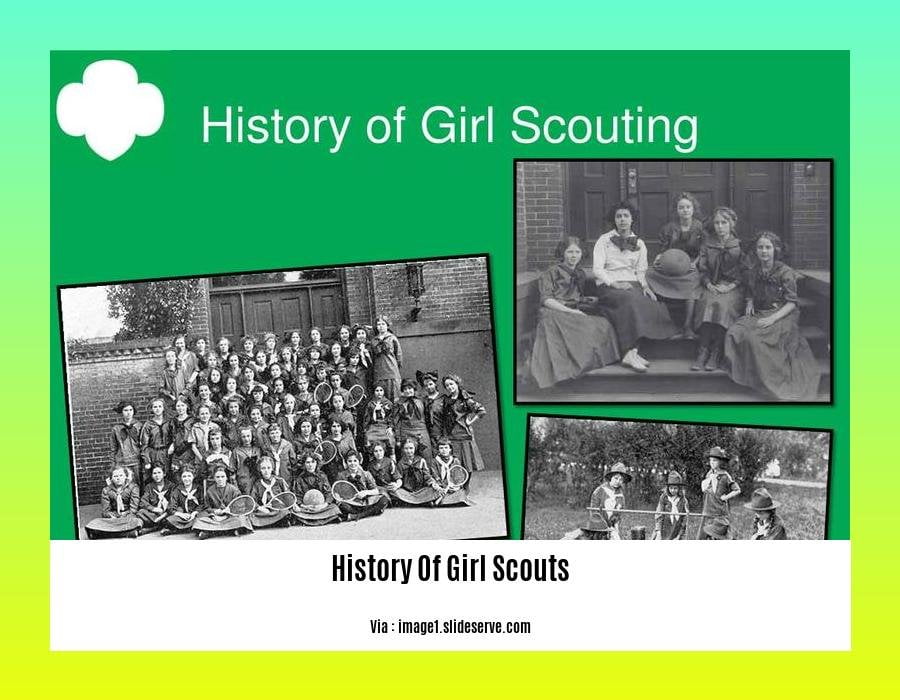Embark on a captivating journey through the annals of history as we delve into [The History of Girl Scouts: A Journey of Empowerment and Transformation]. From its humble beginnings with 18 girls in Savannah to its evolution into a global movement, the Girl Scouts have empowered generations of young women, fostering leadership, resilience, and a commitment to making a difference in the world. Join us as we explore the challenges they faced, the triumphs they achieved, and the enduring impact they continue to have on shaping the future of women’s empowerment and leadership.
Key Takeaways:
- Founded in 1912 by Juliette Low in Savannah, Georgia.
- Chartered by the US Congress in 1950.
- Aims to promote friendship, fun, and empowerment among girls.
- First troop founded in 1912.
- Founder, Juliette Low, met the founder of Boy Scouts, Robert Baden-Powell, in 1911.
History of Girl Scouts


In 1912, Juliette Gordon Low sowed the seeds of a movement that would empower generations of girls. Inspired by the Boy Scouts, she established the Girl Scouts of the USA, a haven where young women could cultivate leadership, self-reliance, and community involvement.
Juliette Gordon’s Vision
Low’s vision was to create an organization that would nurture girls’ physical, emotional, and intellectual growth. She believed in the power of outdoor activities, service projects, and mentorship to shape young women into responsible and capable citizens.
Early Years
The first Girl Scout troop formed in Savannah, Georgia, with just 18 girls. By 1920, the movement had expanded to include over 100,000 members across the United States. Girl Scouts engaged in a wide range of activities, from camping and hiking to first aid and cooking.
Growth and Milestones
In 1950, the Girl Scouts received a federal charter from Congress, solidifying their status as a national organization. Throughout the 20th century, the Girl Scouts continued to evolve, adapting their programs to meet the changing needs of girls. They introduced new badges, initiatives, and opportunities to foster STEM skills, financial literacy, and global awareness.
Legacy of Empowerment
Today, the Girl Scouts remain a vital force in the lives of millions of girls. Through their commitment to leadership, community service, and personal growth, the Girl Scouts have played an instrumental history of girl scouts in empowering countless young women. They have fostered confidence, resilience, and a belief in their ability to make a difference in the world.
To know more about the establishment and organization of the Girl Scouts of America, read more about the History Of Girl Scouts Of America. To know more about the emergence of Girl Scout cookies, read more about the History Of Girl Scouts Cookies.
To know more about the development of the Girl Scouts in France, read more about the History Of Girl Scouts In France. To know more about the organization’s establishment in the Philippines, read more about the History Of Girl Scouts Of The Philippines.
To know more about the woman behind this organization, read more about the Founder Of Girl Scouts. To know more about the establishment of the Boy Scouts of America, read more about the History Of Boy Scouts.
To know more about the woman behind this organization for the deaf, read more about the Founder Of Girl Scouts Deaf. To know more about the organization’s origin, read more about the Origin Of Girl Scouts.
To know more about the woman behind this organization’s house, read more about the Founder Of Girl Scouts House. To know more about the establishment of the Boy Scouts in England, read more about the History Of Boy Scouts In England.
History of Girl Scouts of America
Established in 1912, the Girl Scouts of America has empowered generations of young women, fostering their leadership, self-confidence, and moral values.
Juliette Gordon Low’s Vision
Inspired by Robert Baden-Powell’s Boy Scouts, Juliette Gordon Low founded the Girl Scouts with the belief that girls deserved the same opportunities for adventure, growth, and empowerment.
Early Growth and Expansion
In 1921, the first Native American troop was formed, paving the way for increased inclusivity. By the 1950s, the Girl Scouts had established troops internationally, including in China, Syria, and Mexico.
Peak Membership and Challenges
The Girl Scouts reached their peak membership of 3.7 million in the 1970s. However, they also faced challenges amidst cultural shifts and a decline in traditional membership models.
Adaptation and Evolution
In response, the Girl Scouts evolved their programs to meet the changing needs of girls. They introduced new badges and activities, focused on STEM and outdoor education, and expanded their reach to diverse communities.
Enduring Legacy
Today, the Girl Scouts of America remains an influential organization, continuing to inspire and equip girls with the skills and confidence to succeed in life. Their history is a testament to the power of female empowerment and the transformative impact of youth leadership.
Key Takeaways:
- Founded in 1912 by Juliette Gordon Low
- Focuses on empowering girls through leadership, self-confidence, and moral values
- Established international troops early on
- Faced challenges and adapted over time
- Remains a significant organization empowering girls today
Sources:
FAQ
Q1: When was the first Girl Scout troop established?
A1: March 12, 1912
Q2: Who founded the Girl Scouts?
A2: Juliette Gordon Low
Q3: Where was the first Girl Scout troop organized?
A3: Savannah, Georgia
Q4: When did the Girl Scouts receive their charter from the US Congress?
A4: March 16, 1950
Q5: What is the mission of the Girl Scouts?
A5: To empower girls to develop their leadership skills, self-confidence, and moral values












